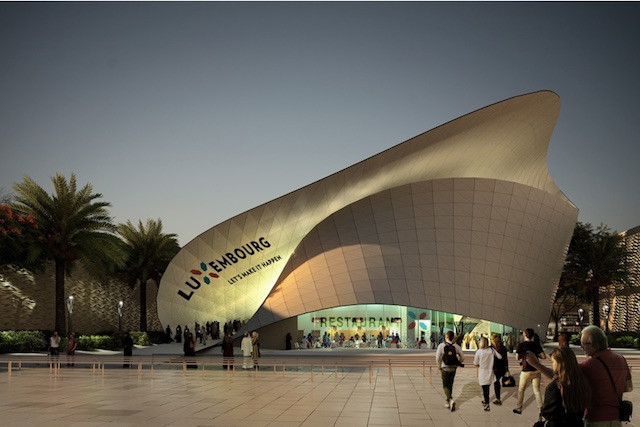Dubai will host the next edition of the World Expo from 20 October 2020 to 10 April 2021 and expects more than 25 million visitors from all around the world. The 200 participating countries’ pavilions, situated across a 438 hectare site, are inspired by the event’s theme “Connecting Minds, Creating the Future.”
The expo’s subtheme “Mobility, Opportunity and Sustainability” drew Luxembourg’s attention as it resonates with its aspirations for the future. Étienne Schneider, minister of economy (LSAP), stated that (PDF):
“the exhibition’s profile matches perfectly with our own national political aspirations for diversification and our economic development in the areas of eco technology, space industry and telecommunication.”
In a public call for projects, architects, engineers and scenographers faced the challenge of representing the whole country and its facets in one single edifice. During the tender process that ran from 17 January to 7 April 2017, 19 designs were examined. The winning pavilion was conceived by the architectural bureau Metaform in collaboration with The Space Factory.
The pavilion’s design mimics the Mobius Strip, a ribbon with neither beginning nor end, intended to represent the country’s circular economy. The face of the ribbon is at once walls, ceiling and floor and serves as a canvas on which interactive animations about Luxembourg will be projected. Metaform explained their idea on the website: “The proposed pavilion is like the country: small and ambitious, intriguing and reassuring, and above all generous and open.”
The pavilion’s interior features a green area that represents the country’s natural heritage and an entire floor is reserved to introduce the space sector. The three levels are connected by a ramp, a slide, stairs and an elevator. Metaform said:
“The journey from the bottom to the top is continuous but constantly changing. The proportions of the space change constantly, in terms of width, height, depth, view, perspective. Due to its very particular and unique landscape, Luxembourg City offers similar changes in perception.”
The pavilion will incorporate cultural components by Luxembourg artists from every discipline: Julie Conrad, Ady El Assal, Guy Helminger, Karolina Markiewicz & Pascal Piron, Simone Mousset, and Patrick Muller. The artists are working together with the architects during a three-year period from January 2018 to April 2021 and are coordinated by the National Culture Fund.
Artist’s rendering of displays inside the Luxembourg pavilion at the Dubai World Expo. Image credit: Metaform.lu
Loïc Bertoli, executive director of the Luxembourg Trade and Investment Office in Abu Dhabi, told Delano that the Luxembourg project is currently awaiting approval from the Expo team and local authorities. A public tender for contractors will be issued soon and construction is scheduled to start in the first quarter of 2019.
Bertoli stated that the World Expo is a great occasion to develop cooperation with the UAE and he predicts that the pavilion will make Luxembourg’s economic opportunities more visible. Headed by Maggy Nagel, a former DP culture minister, the initiative was able to set up an economic interest group, with the government, the Chamber of Commerce, Post and SES.
To fulfil its mission of sustainability, Dubai plans to keep 80 percent of the World Expo buildings intact, in order to “convert it into a vibrant multi-purpose destination with commercial, retail, residential and social attractions and exhibitions,” according to the expo committee’s 2016 annual review (PDF).
With reporting by Jess Bauldry

